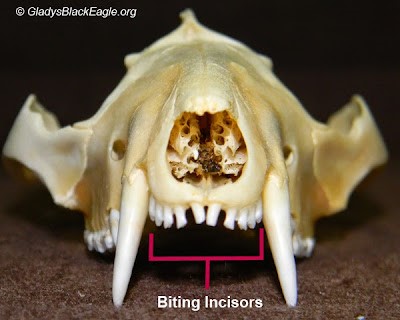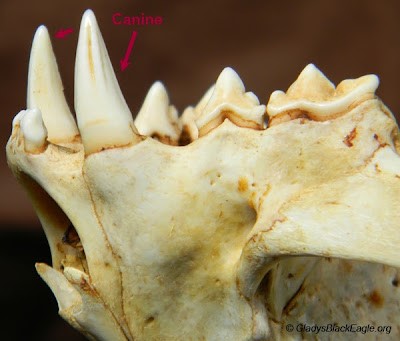Let’s gnaw on this for a bit!
Marla Mertz, Marion County Conservation, and Linette Bernard, Feathers & Ink
What do teeth tell us? Sounds a bit odd, but is often important in animal identification, telling us a great deal about the animal and their feeding habits. Almost all mammals have two sets of teeth. The first set, called ‘milk teeth’ or ‘baby teeth,’ are usually lost sometime after birth and the ‘permanent teeth’ become present and hopefully last for the rest of the animal’s life. There are four general types of teeth and are named in the order from front to back of each jaw: incisors, canines, premolars, and molars. The numbers of each of these types of teeth will vary across species.
Links and books to learn more about skulls plus curriculum:
Links
- Desert Museum curriculum with standards correlation
- Stem-Works: Carnivores, Herbivore and Omnivores
- National Geographic Kids - Carnivores
- National Geographic Kids - Herbivores
- National Georgraphic Kids - Omnivores
Books:
- Illustrated Key to Skulls of General of North American Land Mammals by J. Knox Jones, Jr. and Richard W. Manning
- Skulls and Bones:A guide to the skeletal structures and behavior of North American mammals by Glenn Searfoss
- Animal Skulls: A Guide for Teachers, Naturalists and Interpreters by Richard S. White, Jr., International Wildlife Museum, Tucson, Arizona
- The Wild Mammals of Missouri, Charles W. Schwartz and Elizabeth R. Schwartz - University of Missouri Press and Missouri Conservation Commission
Incisors are the front teeth with sharp edges that are cutting surfaces.

Canines are also called “eyeteeth.” They are often cone shaped, pointed, and located between the incisors and the premolars (or bicuspids). They are used for ripping and tearing.

Premolars (or bicuspids) capped with twin conical peaks are for cutting or shearing. Depending on different books and resources, some refer to the premolars as ‘bicuspids.’ These are the teeth that are located between the canine and molars.
Molars follow the premolars and may be flat for grinding or serrated for cutting.

Teeth are formed of dentin, a calcium phosphate. Inside of the dentin is a soft pulp that is filled with nerves and blood when the tooth is growing. A thin layer of hard enamel can completely or partially cover the dentin. A layer of cement covers the roots of the tooth, but, in the case of certain plant eaters, it may cover the entire tooth. Teeth continuously wear down over time and in old animals may be worn all the way down into the gum line.

Rabbits and rodents gnaw stems and plant fibers and have large incisors shaped like a chisel. Rodents have a single pair of long, curved, chisel edged incisors in both the upper and lower jaws. The incisors are the main indicator of a rodent. Their molars are well developed, are level and often have ridges and grooves. Chewing is normally in a side to side motion. Some teeth, like the incisors of rodents and rabbits, continue to grow through life. These animals have a lot of space between their incisors and their cheek teeth.

Carnivores have large, sharp canine teeth suitable for eating meat. The canines are used for piercing and tearing flesh. Most carnivores have ‘carnassials.’ The carnassials are usually formed by the fourth upper premolar and the first lower molar, working one against the other with a scissor-like action. These are specialized flesh-cutting teeth. Some carnivores, like the black bear, eat large quantities of both plant and animal food and have lower and more rounded rear cheek teeth.
Deer browse on twigs and fibrous plant parts. These types of foods are cut by sharp-cusped cheek teeth before being swallowed and are later ground by the same teeth when the food is regurgitated as “cud. Their molars are flat, well-formed and slant slightly inward. Do you know of any other animals that chew their “cud?”

Shrews and bats feed mostly on insects and other small invertebrates. They have sharp-cusped molar teeth which cut up harder parts of their prey. The incisors of shrews are modified into grasping pincers that hold tight the hard bodies of large insects that the tiny shrew feeds upon.
-
- Test your knowledge with this quick quiz! from Science Kids.
Click through the "Mammal Skulls" album in Google Photos to see the various tooth configurations! Please click the info button to read the captions if they do not appear in the album.

The types, arrangement, and numbers of teeth for any species is called a dental formula which helps in identifying species. The first letter of each type of tooth is used in this type of formula: I for incisor, C for canine, P for premolar, and M for molar. The number of teeth, of each type, in the upper and lower jaws on one-half only is listed from front to rear; those of the upper jaw are placed above those of the lower jaw. The total number of teeth is derived by adding the numbers given in the dental formula and multiplying it by two so that the similar number of teeth on the other half of the jaw is included. Young animals and adult animals formula may be different.
Example:
The dental formula for a coyote is similar to other animals like dogs, foxes, and wolves, which all have 42 teeth. The incisors are 3-3 (lower first, then upper), canines 1-1, premolars 4-4, and molars 3-2. You may also see the dental formula written like this:
I 3/3 C 1/1 P 4/4 M 2/3 = 42 (where the first number is the upper teeth).

You can also look at the skull, see the types of teeth and make an educated guess about the types of food that animal would be best suited to eat. You can take that further and if you know that the animal, let's use the skull above, has incisors, large canines, several premolars, and molars... this animal likely eats a mix of plants / seeds / berries and other animals. Knowing the probable diet of the animal means you can create a simple food chain or food web. Below are vocabulary terms to help you in your exploration!
Vocabulary
Herbivore: Plant eating animals that have cutting incisors and grinding teeth for chewing up various types of vegetation. Examples: white-tailed deer, beaver, muskrat, red squirrel.
Carnivore: Commonly have long canine teeth for ripping and tearing. The front incisors are for cutting. The upper back teeth (molars) overlap the lower teeth for shearing. The meat is ‘cut’ by the teeth into small pieces and swallowed. Examples: coyote, red and grey ox (Dog Family), badger, river otter, Mink (Weasel Family), bobcats, domestic cats -- the molars are the most highly adapted for shearing of any other family of carnivores.
Omnivore: These mammals have adaptations of both the herbivores and carnivores. They may eat just about anything; incisors for cutting, long canines for ripping and tearing, hind molars that overlap on the outside for a shearing surface, but also come together for grinding. Examples: raccoon, skunks, black bear
Insectivore: An animal that eats only, or mainly insects. All teeth are sharp-pointed, suitable for catching, holding and cutting prey. Examples: shrews, bats, moles.
Predator: An animal that hunts and eats other animals for their food.
Prey: An animal that is eaten by another animal or bird.
Food chain:
-
- A system where a small animal is the food for a larger animal which, in turn, is the food for an even larger animal.
- A series of organisms each dependent on the next as a source of food.
Food web: A network of food chains or feeding relationships by which energy and nutrients are passed on from one species of living organism to another.
Most folks connect with stories of life in their community and like to be able to put real life science to task. Teeth can tell us what kind of animal they are, where they may live and what kinds of foods they eat. This may be a huge story in itself, but can lead your imagination to learning much more about our local environment.
published Tuesday, November 1, 2022



